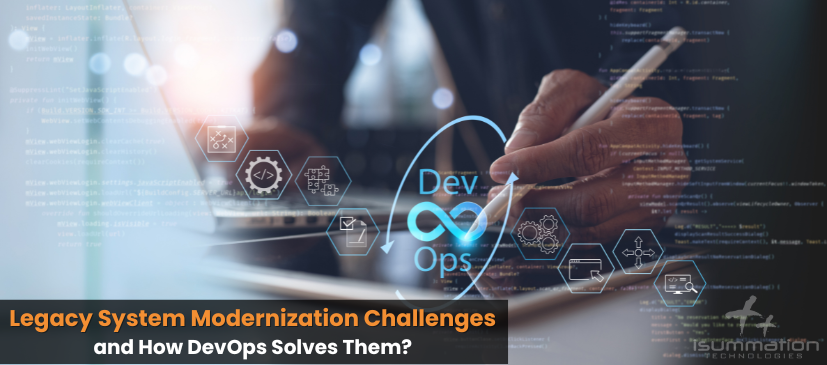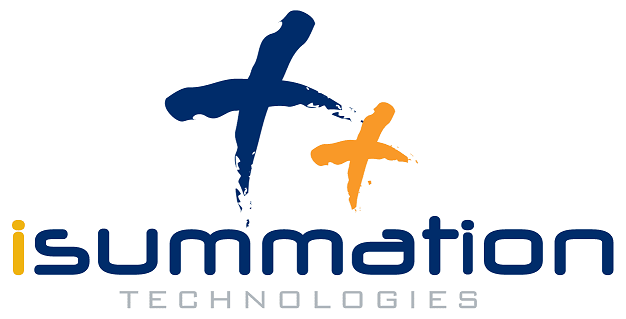- August 26, 2025
- Posted by: iSummation Team
- Category: Strategic IT

Legacy system are the unsung backbone of modern enterprises. While tech headlines buzz with AI breakthroughs and cutting-edge innovations, 70% of businesses still rely on aging platforms to run their most critical operations. These systems, often decades old, present unique challenges that can throttle growth, compromise security, and limit competitive advantage.
The pressure to modernize is mounting. Organizations need agile, scalable, and secure development process to improve their legacy system workflow. However, legacy system modernization isn’t just about replacing old with new, it’s about strategic transformation that preserves business value while enabling future innovation.
This comprehensive guide explores the complex challenges of legacy system modernization and reveals how DevOps practices provide practical solutions for enterprises ready to break free from technological constraints.
Understanding the Legacy System Challenge
What Defines a Legacy System?
Legacy systems are established technology platforms that continue to serve business functions despite their age. These systems often feature monolithic architectures, outdated programming languages, and limited integration capabilities. Many were built decades ago when business requirements were simpler and security threats less sophisticated.
Common characteristics of legacy systems include:
- Aging hardware and software components
- Proprietary technologies with limited vendor support
- Monolithic architecture that’s difficult to modify
- Inadequate documentation and knowledge gaps
- Limited scalability and performance bottlenecks
- Security vulnerabilities due to outdated protocols
The Hidden Costs of Maintaining Legacy Infrastructure
Organizations usually underestimate the cost of maintaining legacy systems. through obvious costs like licensing and technical support, hidden costs concentrate through:
Operational Inefficiency: Legacy systems typically require more manual intervention, leading to increased labor costs and slower response times. Staff spend valuable time on maintenance rather than strategic initiatives.
Security Risks: Older systems lack modern security protocols, making them vulnerable to cyber threats. The average cost of a data breach in 2024 exceeded $4.8 million, with legacy systems being prime targets for attackers.
Integration Complexity: Connecting legacy systems with modern applications requires custom development and middleware solutions, creating technical debt that compounds over time.
Talent Shortage: Searching software developers experienced in legacy technologies looks more difficult and expensive. As experienced professionals retire, organizations face knowledge gaps that threaten system stability.
Industry-Specific Legacy Challenges
Different industries face unique modernization challenges based on their regulatory requirements and operational complexities:
Financial Services: Banking institutions often run core operations on mainframe systems from the 1970s and 1980s. These systems handle billions of transactions daily but struggle with modern digital banking demands.
Healthcare: Medical facilities rely on Electronic Health Record (EHR) systems that may not integrate seamlessly with new diagnostic equipment or telemedicine platforms.
Manufacturing: Production environments use specialized software for equipment control and process management that’s difficult to replace without operational disruption.
Government: Public sector organizations operate on budget constraints while managing citizen services through aging infrastructure that must meet strict compliance requirements.
DevOps as the Modernization Solution
Defining DevOps in the Context of Legacy Modernization
DevOps represents more than a set of tools—it’s a cultural shift that emphasizes collaboration between development and operations teams. When applied to legacy system modernization, DevOps practices enable gradual transformation while maintaining operational stability.
The core principles of DevOps include:
- Continuous integration and continuous deployment (CI/CD)
- Infrastructure as code (IaC)
- Automated testing and monitoring
- Collaborative team structures
- Rapid feedback loops
These principles address legacy system challenges by providing structured approaches to change management, risk reduction, and quality assurance.
How DevOps Transforms Legacy Modernization
Risk Mitigation: DevOps practices reduce modernization risks through incremental changes, automated testing, and rollback capabilities. Organizations can modernize systems gradually without disrupting critical operations.
Quality Assurance: Automated testing frameworks ensure that modifications don’t introduce new bugs or break existing functionality. This is particularly important for legacy systems where documentation may be incomplete.
Deployment Reliability: CI/CD pipelines standardize deployment processes, reducing human error and ensuring consistent results across environments.
Monitoring and Feedback: DevOps tools provide real-time visibility into system performance, enabling teams to identify issues quickly and make data-driven decisions.
Strategic Approaches to Software Product Modernization
Comprehensive Assessment and Planning
Successful product upgrade start with thorough assessment of existing systems. Organizations need to understand their current state before defining modernization strategies.
Technical Debt Analysis: Evaluate code quality, architecture patterns, and integration points to identify areas requiring immediate attention versus long-term planning.
Business Impact Assessment: Determine which systems are most critical to business operations and which modernization efforts will deliver the greatest value.
Resource Planning: Assess internal capabilities and determine whether to hire software developers, partner with specialized firms, or use hybrid approaches.
Modernization Strategy Options
Organizations have several paths for legacy system transformation:
Lift and Shift: Moving applications to cloud infrastructure with minimal code changes. This approach provides immediate benefits like scalability and cost reduction while preserving existing functionality.
Refactoring: Restructuring code to improve performance, maintainability, and integration capabilities without changing core functionality. This approach works well for systems with solid business logic but outdated implementation.
Re-platforming: Migrating applications to new platforms while making targeted improvements. For example, ColdFusion migration from older versions to CF 2025 with performance optimizations.
Rebuilding: Complete application redesign using modern technologies and architectures. This approach offers maximum flexibility but requires significant investment and careful change management.
The Role of ColdFusion Development in Modernization
ColdFusion remains a powerful programming language for enterprise applications development, especially in industries such as, government, healthcare, and finance. However, many organizations run outdated ColdFusion versions that limit performance and security.
ColdFusion Migration Benefits: Upgrading to CF 2025 provides enhanced security features, improved performance, and better integration capabilities. Organizations can modernize existing applications while preserving business logic and user interfaces.
Hiring ColdFusion Developers: Hiring experienced ColdFusion professionals requires targeting developers with both legacy system knowledge and modern development practices. The ideal candidate understands ColdFusion’s evolution and can implement DevOps practices within ColdFusion environments.
Hybrid Development Approaches: Organizations can combine ColdFusion development with modern technologies through API-driven architectures. This allows uniform system modernization instead maintaining system stability.
DevOps Tools and Automation for Legacy Systems
Essential DevOps Tools for Modernization
The right tool selection is crucial for successful legacy system modernization. DevOps tools should support both legacy and modern technologies while providing integration capabilities.
Version Control Systems: Git-based solutions like GitHub, GitLab, or Bitbucket enable source code management for legacy applications that may have limited or no version control.
CI/CD Platforms: Jenkins, Azure DevOps, or GitLab CI provide pipeline automation for legacy systems, enabling automated builds, testing, and deployments.
Containerization: Docker and Kubernetes allow legacy applications to run in modern, portable environments while maintaining compatibility.
Monitoring Solutions: Tools like Prometheus, Grafana, or New Relic provide visibility into legacy system performance and help identify modernization priorities.
Security and Compliance in Legacy Modernization
Addressing Security Vulnerabilities
Legacy systems often lack modern security features, making them attractive targets for cybercriminals. DevOps practices provide structured approaches to security improvement:
Security Testing Integration: Automated security scanning tools can be integrated into CI/CD pipelines to identify vulnerabilities before deployment. Tools like OWASP ZAP or Veracode provide comprehensive security analysis.
Access Control Modernization: Implementing modern authentication and authorization systems, including multi-factor authentication and role-based access controls, significantly improves security posture.
Encryption and Data Protection: Modernizing data encryption both at rest and in transit protects sensitive information throughout the modernization process.
Compliance Requirements
Many industries face strict regulatory requirements that impact modernization strategies:
- GDPR Compliance: European data protection regulations require specific data handling and privacy controls that may not exist in legacy systems.
- HIPAA Requirements: Healthcare organizations must ensure that modernization efforts maintain patient data protection throughout the transformation process.
- SOX Compliance: Financial organizations need audit trails and controls that may require specific DevOps practices and tool configurations.
- ISO Standards: Many organizations pursue ISO 27001 certification, which requires documented security processes and controls that DevOps practices can help implement.
Cloud Migration and Modernization
Cloud-Native Engineering Approaches
Cloud platforms provide scalability, reliability, and cost-effectiveness that legacy on-premises systems can’t match. However, cloud migration needs accurate planning and execution:
Multi-Cloud Strategies: Organizations often benefit from multi-cloud approaches that leverage the strengths of different platforms. AWS provides extensive legacy system support, Azure offers strong Microsoft integration, and Google Cloud Platform excels in data analytics and machine learning.
Containerization Benefits: Docker containers enable legacy applications to run consistently across different environments, simplifying deployment and scaling.
Microservices Architecture: Breaking monolithic legacy systems into smaller, manageable services improves maintainability, scalability, and team productivity.
Application Development in Cloud Environments
Mobile application development practices work well with legacy system modernization:
API-First Design: Creating standardized APIs enables legacy systems to integrate with modern applications and services.
Serverless Computing: Functions-as-a-Service (FaaS) platforms can handle specific business logic while legacy systems manage data persistence and core operations.
Event-Driven Architectures: Cloud-native messaging systems enable loose coupling between legacy and modern system components.
Measuring Success and ROI
Organizations need measurable criteria to evaluate modernization success:
- Technical Metrics: System performance improvements, reduced downtime, faster deployment cycles, and improved security posture provide quantifiable benefits.
- Business Metrics: Customer satisfaction, operational efficiency, cost reduction, and time-to-market improvements demonstrate business value.
- Team Metrics: Developer productivity, employee satisfaction, and knowledge sharing effectiveness indicate successful cultural transformation.
Long-Term Benefits
Legacy system modernization provides benefits that extend beyond immediate technical improvements:
- Competitive Advantage: Modern systems enable faster response to market changes and customer needs.
- Innovation Enablement: Updated platforms provide foundations for new product development and service offerings.
- Talent Attraction: Modern technology stacks help attract and retain skilled developers.
- Operational Resilience: Improved monitoring, automation, and scalability increase business continuity and disaster recovery capabilities.
Conclusion
Legacy system modernization represents one of the most significant challenges facing enterprises today. While the task seems daunting, DevOps practices provide proven frameworks for successful transformation. Organizations that embrace DevOps principles—continuous integration, automation, collaboration, and feedback—can modernize legacy systems while maintaining operational stability.
The key to success lies in strategic planning, phased implementation, and commitment to cultural change. Whether upgrading ColdFusion applications, migrating to cloud platforms, or implementing microservices architectures, DevOps provides the tools and practices necessary for successful modernization.


